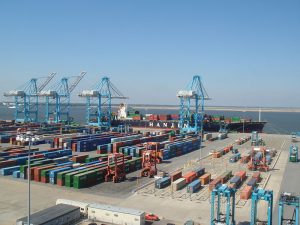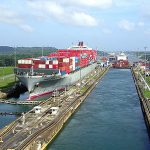Port of Virginia’s Growth Makes it a Major U.S. Port to Watch

Port of Virginia picture by Missy Schmidt from Hampton Roads, Virginia
The Port of Virginia just had a very good fiscal year. In a press release from Port of Virginia Spokesman Joseph D. Harris, the port reported:
The Port of Virginia® handled 231,675 twenty-foot equivalent units (TEUs) in June, a new record for the month and a 7 percent increase when compared with the same month last year. With this achievement, the port completed fiscal year 2017 having handled a record-setting 2.7 million TEUs (twenty-foot equivalent units).
The Port of Virginia has been growing and strengthening its position for quite some time now.
Back in 2015, we posted a blog on the Port of Virginia looking strong in the battle of East Coast versus West Coast ports. The growth the Port of Virginia experienced then was remarkably similar to the growth reported in this fiscal year.
Here are the details from back then:
The port authority reported 7.2% increase from September of 2014 to September of 2015 with cargo container volumes reaching 215,520 TEUs.
September marked the seventh straight month of box volumes exceeding 210,000 TEUs as the mid-Atlantic port continued to receive a portion of cargoes shippers have diverted from West Coast gateways to avoid congestion issues.
…
Containerized exports at the port grew 8.4 percent, while imports were up 5.7 percent.
Year-to-date the Port of Virginia is 8.8 percent ahead of its 2014 volumes with 1.9 million TEUs handled so far in 2015.
The port is also 6 percent ahead of the previous year’s volumes for the first three months of the fiscal year, which began July 1, according to the Virginia Port Authority.
In comparison with last September, rail units were up 16 percent, Virginia Inland Port (VIP) volumes grew 43 percent, truck volumes were up 2 percent and vehicle units were up 133 percent.
With the increased volume, despite the challenges that increase brings, is resulting in growing financial strength for the port. The Port of Virginia reported:
The port’s consolidated financial performance in the first two months of the fiscal year (July/August) is positive as well: Total operating revenues are $80.5 million and the operating income is $3.5 million. The audited fiscal year 2015 results confirmed operating income of $13.6 million in, which is an improvement of $30.1 million when compared with the results from the previous fiscal year.
In 2015, The Port of Virginia, along with the rest of the East and Gulf Coast ports, was in a position to benefit from the contentious ILWU contract negotiations and severe congestion at West Coast ports that had shippers diverting cargo from there.
The expanded Panama Canal continues to give East and Gulf Coast ports opportunity for increased capacity. However, just because larger ships can get through the Panama Canal than before does not mean that East and Gulf Coast ports will automatically experience cargo growth.
The Port of Virginia’s strong and persistent growth is impressive. To get a better feeling for the kind of success this is for the port, here’s more from its press report:
“We finished fiscal year 2017 with a solid volume increase and thus marked our fourth consecutive fiscal year of volume growth,” Virginia Port Authority CEO and Executive Director John F. Reinhart said. “We grew in the right areas, we moved a record-amount of volume across all modes of transportation, train, barge and truck – and did so safely — and we continue to improve our service levels.”
The mid-Atlantic port’s fiscal 2017, which ran from July 1 through June 30, saw cargo throughput increase in several categories, including a 7.3 percent rise in containerized cargo to 2.76 million TEUs; a 7.2 percent jump in total containers to 1.56 million; 568,894 total rail containers, an increase of 11.3 percent; and 950,311 total truck containers, a year-over-year rise of 4.6 percent.
…
“The Port of Virginia team and its labor partners accomplished a lot in fiscal year 2017. We became the leading rail port on the U.S. East Coast; we announced several significant initiatives; we moved record amounts of cargo; we embarked on the biggest expansion – investment — this port has ever seen and we were the first port to host the COSCO Development, which was biggest ship to ever call the U.S. East Coast,” Reinhart said. “We will not let up, there is still much work to be done and we are up to the task.”
The work to be done that Reinhart referred to above includes the projects to expand capacity at the Port of Virginia, allowing it handle the megaships that deliver great quantities of shipping containers at once, as is taking over as the practice of the international shipping industry.
The Port of Virginia obviously plans to continue to grow as it improves its ability to handle more capacity.




